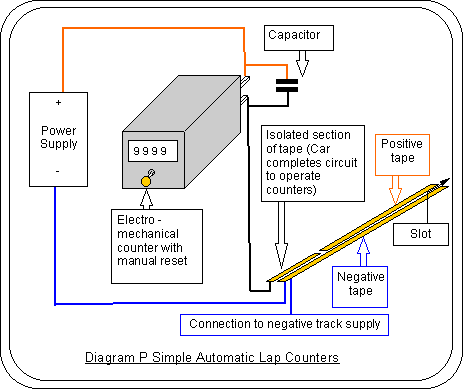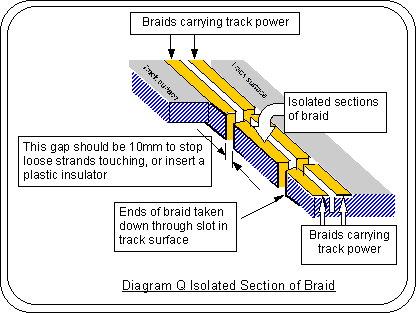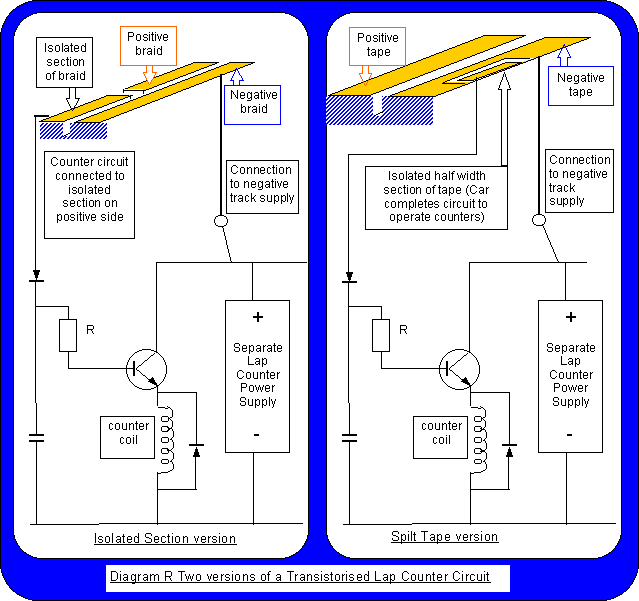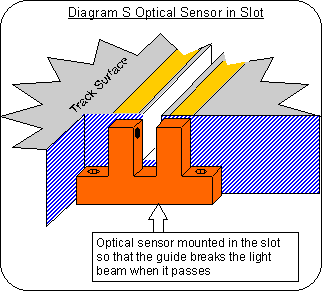Lap Counters
ACCURATE lap recording is
essential for any serious racing. It saves a lot of trouble if the counters are
accurate AND everybody believes they are accurate! Automatic counters can be
expected to count the number of times a car passes the counter section in a
lane. Counters cannot tell which car is passing the counter strip so the race
controller may need to amend the scores if the competitors cannot contrive to go
through the counter section in their own lanes. The number of clubs who have had
trouble getting their lap counters to work properly, it's not so easy as some
people think.
Some makers of home sets have
counters specially to suit their track. This article doesn't attempt to cover
these systems. I don't know of anybody who has tried adapting these for scratch built
tracks - if you know anybody who has made this work successfully why not e-mail me
( slot_racing@yahoo.co.uk ) and I'll add the information to this
page / or links to your page.
The TRACK CONSTRUCTION Part
3 described where to put the counting strip on the circuit. But what do
you put there?
I could jump straight in and
describe the high tech. computer solution, but first lets look at the other
options (ancient and modern). Who knows, perhaps a little more understanding of
how they work may help a club to get several more years service out of their old
counter system and save some money desperately needed to pay the rent!
Hand Counting
Why not appoint one person to
count each lane? As we can assume nearly all slot racers have the intellectual
capacity to count up to 35 (or whatever) this should be an accurate system.
Unfortunately counting laps by hand ranks with counting sheep as an insomnia
cure, so people's concentration soon wanders and counting becomes inaccurate. Add
to this the need for extra people to stand there and count sheep err I mean laps
and it is clear that hand counting is OK as a last resort to complete a meeting
when the proper counters break down, but is not a sensible option under other
circumstances.
Simple Automatic Counting
The simplest system that can work
reliably, and the method that was used by most clubs from the 1960ís is an
electro-mechanical counter and a capacitor. Years ago these counter mechanisms
were much more widely available at low cost (often as Post Office surplus). If
you can find some for few pounds - great!
When I originally wrote these articles, electromechanical
counters were realtively easy to find, these days they are becoming hard to find and expensive - a cheaper and more
readily available
solution is to adapt an electronic pedometer -
click for more info.
Diagram
P shows the circuit.

The counter mechanism counts one when power is applied and
then removed from the terminals. These counter mechanisms work with an
electromagnet pulling in an iron lever which operates a series of wheels by
gears, ratchets etc. All this mechanical stuff does not operate instantaneously.
Typically they need a pulse of 1/50 second or more to operate once, and could
count twice in 1/10 second. How long is a car on the counter strip? Well if
pickup is a bit intermittent it can easily be less than 1/50 second, and
sometimes it will give 2 or more pulses inside 1/10 second. This is why just
connecting the counter mechanism to the counter strip is not likely to work
reliably. The capacitor allows the counter to react to shorter pulses, and wonít
allow a second count in the next few moments, so it can provide a reliable
counting system. These did need some playing with to work properly, missing laps
was dealt with by a larger capacitor or a higher voltage. Double counting was
dealt with by a larger capacitor. Typically people used run the counter
mechanism at a bit above its rated voltage, and capacitor values of 500ĶF.
Incidentally, diagram P shows one lane, everything except the power supply is
needed on each lane (the power supply is common to all the lanes).This circuit only works with the
track wired with one polarity. If your track polarity can be reversed an
isolated strip is needed both sides of the slot as shown in diagram Q below.
Connect one counter wires to each side.
This simple counter works best with a dead
section counter strip. Diagram Q shows how more detail of how a dead section is
built into the track. They are usually 10-20 cm. (4-8 inches) long. Iíve shown
isolated sections of braid both sides of the slot, this gives flexibility for
different counter circuits to be fitted in future. Most circuits use one side as
the isolated dead section, and the other connected to the appropriate power
equally well on braided or tapped
tracks.

There is no power to the car on a
dead section. If a car does stop on the dead section, somebody will have to push
it. Under normal racing conditions cars will coast across the dead bit with no
noticeable change in speed. Its usually only when drivers are trying to stop on
the start line before a race that you notice the dead section.
Split Tape Counter Strips
"Split tape" counter
strips get round the need for a dead section, by providing a half width tape
carrying the power, and an isolated half width (see the right hand half of diagram
R). When
the cars braid bridges the two half widths of tape it completes the circuit and
operates the counters. This tends to give a worse pulse than a dead section, (A
dead section removes the power from the motor so the guide is pressed down into
the slot, and a split tape depends on a wider contact). This sort of counter
strip is not used with braided tracks - try cutting a piece of braid to half
width and you end up with a pile of separate short bits of wire!
Transistorised Lap Counters
There are relatively simple
transistorised circuits that can make the simple counter mechanisms described
above work a lot better. This sort of circuit is usually needed to make split
tape counters work reliably and is used to overcome problems with dead section
counters. There are lots of circuits that could be used, Iíll outline one sort
of circuit - mainly for the benefit of readers who understand a bit about these
sorts of circuits (Iím not going to attempt a how it works from square 1 type
explanation). Variations on the circuit in diagram R have been used on half a
dozen different club tracks in the South West, and always seem to work well.

Essentially
the circuit replaces
the large capacitor in the simple circuit
above with a smaller
capacitor and a transistor to amplify the effect on the counter mechanism. The
small capacitor can charge very quickly without big sparks etc. and the
transistor allows a long enough delay so the counter has time to operate and
doesnít double count.
The lap counters only need a low
current power supply. The exact values depend on the counter mechanisms you can
obtain. Typical 12 volt counters have 500ohm coils so a 15 volt supply would do
fine and it would need to be able to supply at least 120 milliamps for a 4 lane
track. A 10ĶF capacitor will usually give about the right delay (a smaller
capacitor will shorten the delay time) - a cheap 50 v electrolytic will do fine.
Typical components are resistor R 3.3Kohms, the transistor is a BC338 ( BC337,
BC183L, BC184L, BC547, BC548, BC549 or BC550 would do equally well) and the
diodes 1N4001 (1N4002, 1N4003, 1N4004, 1N4005, 1N4006 or 1N4007 would do
equally well). The cost will largely depend on the cost of the counter mechanism
- the power supply should only cost a few pounds and the rest of the components
should be well under a pound per lane.
This sort of circuit could be
adapted to use LCD counter modules in place of electro mechanical counters. (I
havenít built counters using these so I am not certain of the exact component
vales) These modules are available from various electronics suppliers at about
£10 each, they do the same job as electro mechanical counters, but they do it
electronically rather than with magnets, gears etc. Alternatively you could
adapt an electronic
pedometer.
However, there is no need to
replace electo-mechanical counters that are working reliably - I know of one
club that are still getting satisfactory service from counter mechanisms that
have been in use since 1968 (and they did work better once the original big
capacitor was replace with a transistorised circuit in 1978).
This split tape circuit only
works with the track wired with one polarity. If your track polarity can be
reversed the isolated strip version needed. This works with either polarity, but
needs the gap between isolated section and the powered section needs to be small
enough so that the car's pick up braid will bridge the gap. This might
sound a bit dubious, but in fact works entirely reliably even with Scalextric,
Ninco etc. cars (which in standard form have a very small pick up area, so are
the most severe test of this type of circuit).
Optical Detectors
Clubs with the benefit of a member with the
necessary electronic knowledge often used a light beam to operate the counters.
The counter mechanism itself was often the sort of electro-mechanical counter
used in the simple lap counter. I wonít attempt to describe the circuits to
connect the two (see *). Some clubs used photocells in the bottom of the slot with a
light shinning from above. More common is a single slotted package containing
both the light source and detector (see Diagram S).

These systems can work well.
There are occasional problems with muck in the slot blocking the light path (the
cure is obvious once you figure out what has happened). Its important to get
the depth right - the guides on
Scalextric type cars are not as deep as the Starburst, Cahoza or Jet Flag guides BSCRA
racers are used to. One advantage of optical detectors is that there is no dead
section of tape. A potential difficulty is noise pickup causing false counting -
well sorted systems are immune to this problem, but some clubs resident
electronics experts have spent months trying to sort out this sort of problem.
This type of detector is isolated from the track
wiring, so works equally well with either track polarity.
*The optical sensor by itself won't do anything!
The important bit is the circuit joining the detector to the computer or counter
mechanism. If you have a club member with the
necessary electronic knowledge to design and build this - great. If not
you'd be better off with a simpler system.
Computerised Race Control Systems
The lap counters described above do just that - count laps. Its up to the race controller
with pen and paper to write out the heats, record the scores, add up the results
and arrange them in order. The races have to be timed or the power turned off
after a fixed number of laps - another job for the race controller with the aid
of a stop watch or an automatic timer. A computer race control system will do
all these jobs as well as count laps. A race control system consists of a
standard computer (invariably an "IBM compatible" PC) and race control
package (some software plus some hardware to connect the computer to the track.)
Which Package?
Which is the best package to buy?
To give a proper answer to that I would have to have run race meetings with all
the packages available. There are lots of packages available in America, most of
which have not been tried in this country. Its a good idea to look at suppliers
demo discs or web site to get a clearer idea of all the facilities they offer.
Although the basic use of such systems can be picked up quickly, it takes some
time to become an expert user. Advice from an experienced user of a race control
package can be invaluable, so its not a good idea to be the only UK user of a
package. So what packages are successfully used in the UK?
SLOTMASTER was written for
British club racing, (My experience is using it on the BSCRA Nationals
track, Bournemouth
SRS and Tomacher raceway. It is used for club racing and BOC meetings at a number of other
tracks.) It runs on
Windows, runs on a 386 or better PC and will support 2 to 8 lanes. It has
facilities to work out parts of a lap automatically (so there is no need to find
out which hundredth the car stopped on) and will time to 1/1000 sec (if you run
it on a 66 MHz 486 or better PC). The under £100 entry level system lacks the power switching, the higher spec versions
with full facilities work through a card plugged into one of the expansion slots
in the PC.
AUTO TRACK was originally written
for American raceways. It runs on DOS and will support 8 lanes and is
particularly suited to segmented racing, it will also time individual laps to 1/1000 sec. It
has been used for ISRA World
Championships run it the UK, and was also used on the Pinewood 6 lane track. You
can order your Steve Ogilvie track with Auto Track.
LAP
MASTER is the more recent system which has a number of interesting features
including a audio output giving race positions etc. This is used on
the BSCRA X Track and "Monster" National Championship track and at the new
Pinewood track. It needs a computer with Windows XP or later
operating system.
RACE
COORDINATOR - This is widely used
at clubs. This has good online support and there are plenty of other users
if you need any help ,
I'm always happy to update this
page with systems that I've seen working well. No doubt there are some good
systems out there that I haven't seen. However, some manufacturer's claims are,
shall we say, a little optimistic - so I'll need to see something working
well before I'll add it to this web site. If you know all about some other
good packages, why not e-mail me ( slot_racing@yahoo.co.uk
).
Do you need a dead section, split
tape or optical detector for a computerized system? The suppliers of race
control packages will tell you what their system needs. Choose your race control
package first, then sort out a suitable detector. Will it work with reversed
polarity? Again the answer is check with the supplier.
What PC?
No doubt some of the more experienced
web surfers who read this page will be far more knowledgeable on this topic than I
am - but for the rest of us.........................Isnít a computer expensive? -
Well it depends what you call expensive. A bottom of the range new computer will
set you back over £400, but this is way in excess of the spec. needed to run
even the best current lap counter packages. Where as the latest computer games
or the latest office automation "bloatware" continually depend on ever
higher spec PC hardware, the writers of lap counter packages know most slot
racers prefer the low cost of relatively out of date hardware. As home computer
enthusiasts and companies are frequently needing to upgrade their PCs to run the
latest packages, there are plenty of "previously enjoyed" (or possibly
"previously cursed" at work) PCs available for not much money -
several places advertise old Pentium PCs for around £50 - and these are entirely
adequate for lap counting purposes. It is not uncommon for superseded computers
to be scrapped, so if you are in the right place at the right time, the previous
owners may be happy to give them away rather than put them a skip.
Any cautionary notes on buying
second-hand PCs? Firstly find out what spec your chosen race control package
needs, and make sure you buy something adequate. If you buy from a
reputable trader, you should get a few weeks warranty, so check it out as soon
as possible. If buying privately, check it works before you buy - you wouldnít buy a second had
car without a test drive! People are usually just selling hardware which is
obsolete for their purposes, but there might be a few bits of duff hardware
mixed in (duff hard drives, duff monitors and connectors with bent pins are the
most likely problems). Obviously if it's free just say thank you -
unless it's obviously trashed it's worth a try!
If it comes with an obsolete operating system
(for example Windows XP, 98, 95
or the even older DOS and
Windows 3.1) leave well alone - upgrading to later versions of Windows (e.g.Windows
7 or 10) can slow old
computers to a halt and fill up too much space on their small hard discs. Lastly - but very important - the lap counter package will probably
have a printed circuit card that plugs into one of the expansion slots inside
the computer - make sure your computer will take the necessary card. (The cards
are pretty standard so this shouldnít be a problem with a desk top but check before you buy
just in case.)
Its worth thinking about security
- a computer is the sort of thing that may attracts theft - and in reality
there's not much else in the average club rooms that's anything like as worth
steeling (unless you leave the club funds lying around in cash). So think about
making your club room secure before you get a computer - the risk is not just
the nicked computer but the amount of other damage from a break in. Desktop
computers donít travel well, so its not really practical to take it home each
week. Laptop PCs travel better, however I donít know of any system that runs
on one, and these generally lack expansion slots so there are difficulties in
getting a system to work on a laptop.
Tracks with lap counters and
start lines in different places. See
separate section
There is much more that could be
said about computerized race control systems, but I think I better leave that
for another time. The next in this series of articles will look
at wiring up your track.
Chris Frost
Copyright © 1999,
2000 and 2001 C.Frost with minor updates in 2002 - 2016
All rights reserved
No liability is accepted for
the information on this site or any use to which it may be put.




